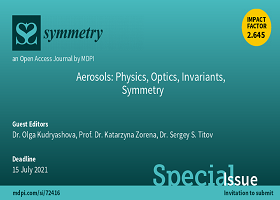Dispersed Systems: Physics, Optics, Invariants, Symmetry
A special issue of Symmetry (ISSN 2073-8994). This special issue belongs to the section "Physics".
Deadline for manuscript submissions: closed (31 July 2022) | Viewed by 8908

Special Issue Editors
Interests: materials; acoustics; ultrasonics; mathematical modeling
Interests: medicine biochemistry; genetics and molecular biology; immunology and microbiology; pharmacology; toxicology and pharmaceutics environmental science; neuroscience; social sciences
Special Issues, Collections and Topics in MDPI journals
Interests: development of methods and algorithms for processing experimental data to implement optical measurement techniques of aerosol disperse characteristics
Special Issue Information
Dear Colleagues,
Physics and mechanics of disperse systems form part of the mechanics of gas and liquid. In the formulation and solution of problems in the mechanics of gas and liquid, methods of similarity theory are widely used; when using this theory, anything from physical quantities all the way to some of the dimensionless invariants may be identified by researchers, which shows a deep physical reflection of the interaction of various phenomena.
Disperse systems as systems in two-phase states exhibit a variety of new properties in comparison with a continuous medium, and they are widely used in technological processes and medicine. However, there are also unsolved environmental problems associated, for example, with aerosol pollution.
There are fundamental and applied problems associated with measuring the size and concentration of disperse particles. Optical measurement methods imply the development of the optics of disperse systems, in which the symmetry or asymmetry of the radiation scattering indicatrix plays an important role.
The aim of this Special Issue is to highlight the importance of the concept of symmetry in physics, mechanics, and optics of disperse systems.
We require contributions—research and review articles—covering a broad range of topics in physics, mechanics, and optics of disperse systems, and symmetry, including, though not limited to, the following:
- Similarity theory in solving problems of mechanics of disperse systems;
- Similarity criteria in various problems of physics of disperse systems;
- Symmetry in the creation, evolution, and propagation of disperse systems;
- Symmetry and asymmetry manifestations in optics of disperse systems;
- Symmetry in nanoparticles;
- Applied problems focusing on the role of symmetry in the science of disperse systems.
Dr. Olga Kudryashova
Prof. Dr. Katarzyna Zorena
Dr. Sergey S. Titov
Guest Editors
Manuscript Submission Information
Manuscripts should be submitted online at www.mdpi.com by registering and logging in to this website. Once you are registered, click here to go to the submission form. Manuscripts can be submitted until the deadline. All submissions that pass pre-check are peer-reviewed. Accepted papers will be published continuously in the journal (as soon as accepted) and will be listed together on the special issue website. Research articles, review articles as well as short communications are invited. For planned papers, a title and short abstract (about 100 words) can be sent to the Editorial Office for announcement on this website.
Submitted manuscripts should not have been published previously, nor be under consideration for publication elsewhere (except conference proceedings papers). All manuscripts are thoroughly refereed through a single-blind peer-review process. A guide for authors and other relevant information for submission of manuscripts is available on the Instructions for Authors page. Symmetry is an international peer-reviewed open access monthly journal published by MDPI.
Please visit the Instructions for Authors page before submitting a manuscript. The Article Processing Charge (APC) for publication in this open access journal is 2400 CHF (Swiss Francs). Submitted papers should be well formatted and use good English. Authors may use MDPI's English editing service prior to publication or during author revisions.
Keywords
- similarity theory in aerosol mechanics
- similarity criteria in aerosol physics
- symmetry in the creation, evolution, and propagation of aerosols
- symmetry and asymmetry in aerosol optics
- symmetry in nanoaerosols
- applied problems focusing on the role of symmetry in aerosol science
Benefits of Publishing in a Special Issue
- Ease of navigation: Grouping papers by topic helps scholars navigate broad scope journals more efficiently.
- Greater discoverability: Special Issues support the reach and impact of scientific research. Articles in Special Issues are more discoverable and cited more frequently.
- Expansion of research network: Special Issues facilitate connections among authors, fostering scientific collaborations.
- External promotion: Articles in Special Issues are often promoted through the journal's social media, increasing their visibility.
- e-Book format: Special Issues with more than 10 articles can be published as dedicated e-books, ensuring wide and rapid dissemination.
Further information on MDPI's Special Issue polices can be found here.







